 |
|
|
 |
||
MASS TOURISM and the MEDITERRANEAN MONK SEAL (continued)
W.M. Johnson & D.M. Lavigne
DISCUSSION
 |
|
|
 |
||
MASS TOURISM and the MEDITERRANEAN MONK SEAL (continued)
W.M. Johnson & D.M. Lavigne
DISCUSSION
Assessing tourism as a threat to the monk seal
Contrary to conventional wisdom, the threat of tourism to M. monachus began deceptively early in the Mediterranean. On the islet of Bisevo in the Adriatic, boats first ferried tourists into monk seal habitat and the famous Blue Cave in 1848 (Draganovic 1991). In 1935, two monk seals were captured by tourists in Sardinia (Lungo 1935). On the same island, the Grotto of Neptune, another well-known haunt of the monk seal, was first developed as a tourist attraction in 1958 and, by the 1970s, it was being visited by some 35,000 tourists every year (Scott 1972).
Monk seal numbers appear to have declined in inverse proportion to tourism’s explosive growth along Mediterranean coasts. Today, the shores of the Mediterranean, home to 130 million people, act as a lure to a further 110 million tourists every year, many of them squeezed into the two high season months of July and August (Johnson 1988, Anon. 1995, WTO 1997). In the early 1980s, this was said to represent one-third of the entire world tourist trade, imposing an enormous burden on coastal and marine environments in terms of pollution, overfishing and habitat destruction (Lean 1982, Ronald & Yeroulanos 1984).
There also appears to be little or no disagreement regarding the tourism industry’s responsibility in contributing to the plummeting fortunes of the monk seal. From 1978 to 1998, all major scientific conferences focusing on M. monachus concluded that tourism poses a significant threat to the continued survival of the species (e.g. Ronald & Duguy 1979 & 1984, Council of Europe 1986a UNEP/MAP 1987, 1988, 1994).
Indeed, evidence suggests that expanding tourism has now assumed unrivalled significance in the fate of the species. In the Ionian and Aegean seas of Greece, for example, which hold the world’s largest surviving monk seal population (Brasseur et al. 1997, Dendrinos 1998), it is now generally acknowledged that tourism and deliberate killing represent the two greatest threats to the species (Ronald & Duguy 1979, Jacobs & Panou 1996).
In contrast to other historical threats (such as hunting or entanglement in fishing gear) that have diminished over time (due in no small measure to population decline), the tourism industry holds the clear potential of presiding over the extinction of the species in the Mediterranean. There are at least two compelling reasons for drawing this conclusion. First, the surviving population largely occupies geographical regions now dominated by tourism (Brasseur et al. 1997). Second, mass tourism has already been implicated in the extinction of monk seal populations in extensive areas of the species’ historical range, including Croatia, France, Italy, Spain and Tunisia (Fig. 3) (see Regional Assessments). In addition, it remains a serious and immediate threat throughout the species’ last stronghold in the Mediterranean: Greece and Turkey.
The accumulated evidence suggests that mass tourism may be a particularly efficient exterminator of monk seals because of the multiple threats with which it confronts the species. We discuss these below.
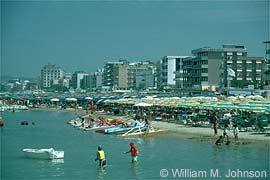
Fig. 3. Mass tourism has been implicated in the eradication of the monk seal
in several Mediterranean countries, including Italy.
Loss of habitat through construction
Direct assaults on seal habitat through the construction of hotels, roads, marinas and other tourist amenities have long been recognised as a major threat to the species (e.g. Ronald & Duguy 1979, Berkes et al. 1979, Sergeant et al. 1979). Regrettably, monk seal research has never been geared towards a systematic collection of data capable of documenting the development of monk seal habitat. Nevertheless, several specific examples can be found in the scientific literature, suggesting that loss of habitat to tourism construction may be a common phenomenon, particularly where environmental impact assessments (EIAs) are inadequate or nonexistent.
In the Ionian Sea, a hotel construction project in the Straits of Ithaca was approved despite being in immediate proximity to caves frequented by seals (UNEP/MAP 1994b). Similarly, at Akyarlar Cape on Turkey’s tourism-dominated Bodrum Peninsula, a massive hotel complex has recently been constructed directly above a monk seal cave, despite an alleged EIA (Fig 4). This particular cave had been deemed suitable for both resting and breeding by monk seals (Kiraç & Veryeri 1996). During a visit to the area in 1997, local fishers stated that the cave was still intermittently occupied by seals, though for how much longer must remain seriously in doubt, since the resort complex at that time had not yet been completed.
A large and controversial hotel complex has also been constructed over a monk seal cave in Cyprus in the Asprokremmos area (Fig 5), jeopardising one of the species’ few remaining habitat areas around the island (Dendrinos & Demetropoulos 1997, Panos Dendrinos, pers. comm. 1999).
Fig. 4. A hotel complex constructed above a monk seal cave on Akyarlar Cape, Bodrum Peninsula, Turkey.
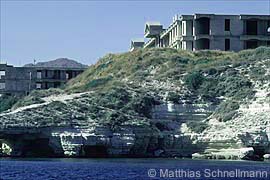
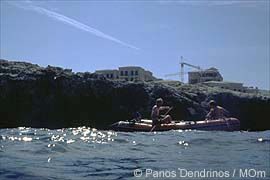
Fig. 5. A hotel complex constructed over a monk seal cave in the Asprokremmos area of Cyprus.
Despite the fact that specific tourism development projects have rarely been studied for their impact upon the monk seal, it appears likely that such construction has deprived the species of broad swathes of habitat, and continues to do so.
A case in point is the Cilician Basin on Turkey’s Mediterranean coast. The dangers posed by tourism to resident monk seals were predicted by the late Turkish scientist Bahtiye Mursaloglu in 1984. Without rapid action to protect this area, claimed Mursaloglu, a stretch of coastal habitat virtually untouched by tourism development pressures would be lost forever (Ronald & Duguy 1984). However, tourism is now a burgeoning industry in the area, and is regarded as a serious threat to surviving monk seal populations (Karakoc & Karakoc 1997, Güçü 1998). Antalya and its environs – a major gateway to the Cilician Basin – is swelled by over 2 million people during the high season summer months, generating a self-perpetuating construction boom, pollution, degradation of sensitive wildlife habitat and archaeological areas (Holdsworth 1993).
Loss of habitat through disturbance
While coastal development obviously poses its own brand of habitat destruction, the millions of tourists who flock to coastal resorts during the summer months may present an even greater threat to the survival of the monk seal.
Despite seeking refuge on barren, cliff bound coasts and islets, a boom in pleasure boating during the second half of the 20th century has meant that even the most remote and inaccessible shores have come under intensifying disturbance by tourism (Johnson 1988, Johnson & Lavigne 1999).
In Greece, researchers have recorded the monk seal’s limited tolerance for human disturbance, with animals abandoning habitat when disturbance rises above certain critical levels (IUCN/UNEP 1988, Jacobs & Panou 1996). On the Ionian island of Kefalonia, increased disturbance by leisure boat traffic (including penetration into caves) was implicated in the decline of seal sightings during the high season (Jacobs & Panou 1996), a finding applicable to many other areas of coastal Greece (MOm 1996a, Archipelagos/MOm 1996, Karamanlidis 1997).
A similar phenomenon was also recorded in Turkey by Mursaloglu during cave surveys in 1980. Of the many deserted breeding caves discovered along the densely populated Aegean coast, all were found to be in close proximity to tourist activity, tourist resorts or industrial development. Conversely, Mursaloglu found that caves still actively used by seals were far removed from human disturbance. "Security against disturbance," she concluded, "is considered to be of utmost importance for the survival of the pup because of a long lactation period of four months and the related prolonged strict dependence on the mother" (Mursaloglu 1980, 1984).
The sheer numbers of beach-loafing and water-bourne tourists pose particular difficulties for monk seals, effectively evicting them from their habitat during the summer period. Researchers in Kefalonia, for example, comparing the numbers of tourists present in the habitat area in various months of the year, recorded a 1000% increase in individual tourists occupying beaches between the high and low seasons and a similar rise in leisure boat traffic. In contrast, during the five winter months (November-March) the area received no tourism at all (Jacobs & Panou 1996).
While seals may return to their caves in the quiet off-season months (Harwood 1987a, WWF Mediterranean Programme 1994, Jacobs & Panou 1996, Karamanlidis 1997), evidence suggests that it would be wrong to downplay the significance of this phenomenon for two reasons: (1) The tourism season partially coincides with the monk seal breeding and pupping season, and (2) Tourism pressures are capable of destroying coastal habitat to such an extent as to rule out such seasonal behaviour (Jacobs & Panou 1996).
In the Gulf of Orosei in Sardinia, research during the mid-1970s indicated that seals abandoned caves during the holiday season, which brought 20,000 tourists a year flocking to the area. Confronted by numerous pleasure craft and speargun divers, it was concluded that the resident seals either found haul-out areas on more remote stretches of coast, or simply stayed out at sea for the duration (Bareham and Furreddu 1975). Ominously, perhaps, the monk seal is now effectively extinct in the Gulf of Orosei, notwithstanding strenuous efforts to exploit the species’ ghost as a tourist attraction (Johnson 1998a).
Elsewhere, seals may continue to inhabit caves in the general vicinity of seasonal tourism build-up, but only if such shelters provide additional security from human disturbance (Jacobs & Panou 1996). Unfortunately, there is reason to suspect that the characteristics of some caves used by the monk seal as a refuge from persecution and harassment are inherently incapable of providing the habitat required to meet the biological needs of the species (Johnson & Lavigne 1999).
Disturbance leading to deteriorating habitat
Accumulated evidence suggests that, in relatively recent history, disturbance and persecution has driven the Mediterranean monk seal into increasingly marginal habitats. A comprehensive review of this trend (Johnson & Lavigne 1999) records various phases in this progressive deterioration:
While shelters of types (3) and (4) might be regarded as the bare minimum required to meet the biological needs of the species, research during the late 1970s indicated that numerous caves in use by the species fell below even this marginal standard (Anderson 1978 & 1979, Ronald & Duguy 1979).
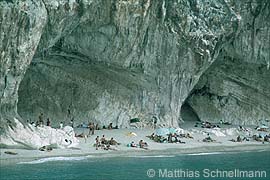
Fig. 6. The great ‘arching caverns’ of the Mediterranean were once traditional habitats of monk seals,
but eventually proved too vulnerable to hunting pressures and tourism disturbance.
The risks to the species are potentially far-reaching. As indicated above, habitat deterioration has acted selectively against colony formation, in favour of individuals or mothers with pups (Johnson & Lavigne 1999, Sergeant et al. 1979). By severely limiting social interaction, mating and breeding success has presumably been compromised (Johnson & Lavigne 1999). In addition, storm surges may cause breakers to funnel into caves, washing nursing or recently weaned pups into the sea to be swept away and killed (Anderson 1978 & 1979, Johnson & Lavigne 1999).
By the late 1970s, it was concluded that the cave habitat occupied by the monk seal may not be adequate for the survival of the species, and that some return to sandy beaches might be essential to promote recovery (Sergeant et al. 1979, Ronald & Duguy 1979).
However, with human disturbance and harassment increasing dramatically since then, there is evidence to suggest that cave habitat may be continuing to deteriorate. Certified divers and researchers in Turkey have recently discovered monk seals occupying underwater entrance caves that can only be accessed through narrow tunnels cutting almost a hundred metres into cliff faces (Cem Kiraç, pers. comm. 1998). In some areas, seals have been discovered inhabiting caves that are, in reality, little more than water-filled crevices. With no internal beach or haul out area, the animals are obliged to rest or sleep while floating in pools (Fig. 7) (IUCN/UNEP 1988, Johnson & Lavigne 1999).
It appears unlikely that caves of this type can meet the essential biological needs of the species. The same conclusion might also apply to less extreme forms of marginal monk seal habitat, where breeding viability is severely compromised by a number of factors associated with the characteristics and constraints of the habitat in question. These include reduction in gregarious behaviour (for which the species was so famed in antiquity), fecundity and pup survival (Anderson 1978 & 1979, Texel 1990, Johnson & Lavigne 1999).
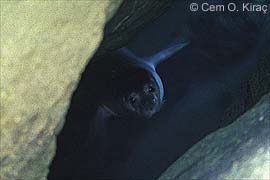
Fig. 7. An adult female seal seeks shelter in a crevice-like cave on the Turkish Aegean.
Effects on breeding
Tourism may also impact the monk seal’s breeding success in a more direct way. As noted previously, while abandonment of caves may be a seasonal reaction to disturbance in certain areas, the fact that the disruption partially coincides with the seal breeding and pupping season may have insidious, long-term repercussions for the survival of the species.
Even where no harmful intent exists, disturbance caused by tourists entering into caves may have dramatic consequences. The behaviour of monk seals, when confronted by humans in caves, can also have unforeseen effects. In contrast to adults, alarmed pups tend to flee further into caves rather than into the open sea, thus rendering them particularly susceptible to deliberate harm, and exacerbating the likelihood of mother-pup separation (Ronald & Yeroulanos 1984, IUCN/UNEP 1988). Disturbance during the pupping season can seriously endanger the pup’s chances of survival by breaking the maternal bond (van Haaften & Reiner 1984, Israëls 1992).
Disturbance has also been implicated in monk seals aborting their young (Ronald & Duguy 1979). At the popular Grotta del Bue Marino (Cave of the Sea Ox) in Sardinia, Bareham and Furreddu (1975) discovered six aborted foetuses on a beach at the mouth of the cave between 1965-1970, possibly the result of tourist disturbance (Johnson 1998a).
Tourist development may also be responsible for disrupting breeding movements between seal populations. In the Eastern Aegean, for example, coastal tourism appears to be destroying monk seal habitat on both the Turkish mainland and Greek island coasts, possibly disrupting breeding movements that once sustained interrelated sub-populations (Berkes 1978, Ronald & Berkes 1979). The problem may be particularly acute in Kos and the Bodrum Peninsula (Kiraç & Veryeri 1996).
Deliberate killing and harassment
Though available data are limited by under-funded research efforts, by the large geographical areas involved, and by the issue’s potential sensitivity, there is evidence to suggest direct killing and malicious harassment of monk seals by tourists on certain occasions.
The last 3 monk seals in the Galite archipelago of Tunisia appear to have been killed by tourists, one of them speared by a snorkelling Italian diver (Anselin & van der Elst 1987, Johnson 1988, UNEP/MAP 1994b). A similar incident was recorded along the Aegean coast of Turkey (Berkes et al. 1979). There are also at least two reports of monk seals being killed by divers fishing with spearguns along the Mediterranean coast of Morocco (UNEP/MAP 1998b). Rather more incredibly, a survey of monk seal mortality published in 1991 revealed that one pup had been killed with a speargun by a snorkelling tourist and then eaten (Cebrian & Vlachoutsikou 1991). Van Wijngaarden (1969) also reported that two French tourists captured a seal on the Côte des Phoques with the intention of taking it home with them, although the animal’s ultimate fate remains a mystery.
Occasionally, harassment (even if innocently motivated) may backfire on the tourist rather than the seal. A curious Austrian tourist approaching an ailing seal off Karpathos in 1997 suffered a bite serious enough to require emergency medical attention (a tooth had broken off in the wound). The seal was found dead a few days later, apparently due to natural causes (Eugenia Androukaki, pers. comm. 1997).
Exploitation by the tourism industry
Despite press and media attention in recent years, the monk seal remains an obscure, largely unknown inhabitant of the Mediterranean sea. Its secretive habits and plummeting population appear to prevent any systematic exploitation by the tourism industry, yet there are exceptions to the rule.
An article in a Turkish magazine, for example, described the sightseeing lure of the famous Blue Cave on the Mediterranean coast beyond Kas. Prior to its discovery by the Turkish Tourism Association for Cave Exploring and Promotion, the grotto had been known simply as the ‘Seal Cave’ by local fishermen because of the large numbers of seals that once inhabited it (Dougan 1988).
In other areas, the exploitation may be far more cynical, as in the case of Cala Gonone in Sardinia. Despite successfully quashing efforts to establish a marine park in the Gulf of Orosei, and the subsequent eradication of monk seals from the area by tourism pressures, local tour operators and shopkeepers continue to offer popular day trips to the famous Grotta del Bue Marino (Fig. 8), continue to market a variety of monk seal merchandise, and to promote the monk seal as the community’s unique corporate identity (Johnson 1998a). Indeed, guidebooks and internet sites promoting Cala Gonone explicitly offer tourists the hope of seeing a monk seal, and even highlight the species’ rarity as an additional attraction (e.g. Touring Club Italiano 1999, Italia Turistica 1999).
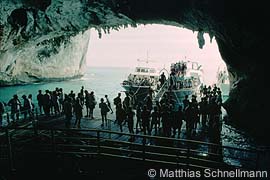
Fig. 8. Day trips to the famous Grotta del Bue Marino.
During the early 1970s, local fishers, plying between the resort town and the grotto in boats converted into tourist ferries, insisted that they would not kill the monk seals because they now regarded them as a tourist attraction and a source of revenue. Increasing disturbance, however, soon brought a lethal debunking to this early example of sustainable, non-consumptive utilisation of species (Johnson 1998a). Scott (1972) states that the sole surviving individual was deliberately killed by a local fisher who resented his rival competitor’s success in taking tourists to view it.
At Lopar on the Croatian island of Rab, the official tourist organization promotes the Medova Buza cave as one of its main attractions. The cave, according to its Internet site, is "long since known as the habitat of the Mediterranean monk seal." Rather more incredibly, it also adds that in the cave, "international weddings are arranged for lovers of the out-of-the-ordinary" (Tourist Organization Lopar 1997).
Similarly, a web site extolling the virtues of Poros, a community on the Ionian island of Kefalonia, is illustrated by a photograph of a white-bellied neonate monk seal pup. Poros’ caves, the site declares in an obvious lure for tourists, offers shelter for the monk seal (Ionion 1999). Another site promoting Greek tourism and, in particular, Kephalonia, states that the monk seals, "a protected species," can be found in caves along the northern coasts of the island (Travel in Greece 1999).
Accompanied by a photograph of a startled monk seal in a cave, Aegeus Yachts of Greece promotes (among other destinations), the Northern Sporades island of Skiathos. Its Internet site states that "This is probably the last breeding ground in the eastern Mediterranean sea of the seal Monachus Monachus" [sic] (Aegeus Yachts 1999). Another charter group promoting holidays to the Northern Sporades notes that a National Marine Park has brought protection to the Mediterranean monk seal, and suggests that the animals "can be sighted on the small deserted islands" to the north of Alonissos (Holiday Islands 1999).
The local, English-language newspaper of Symi, an Eastern Aegean Greek island, also promotes the presence of "the world’s most endangered species of mammal" [sic], and informs readers where the half dozen survivors on Symi may be found (Symi Visitor 1998).
Also in Greece, the prominent travel agent chain Manos uses the name and image of the monk seal to promote its business activities, yet appears to provide no educational contribution or sponsorship to monk seal conservation activities. Similarly, Nomikos Lines has coined the advertising phrase "Swim in the Waters of Monachus monachus" to promote its ferry service to the Northern Sporades, yet also provides no tangible support to preservation efforts (Vrassidas Zavras, pers. comm. 1999).
An Internet site aimed at the scuba diving market suggests that "divers can enjoy the plentiful marine life" around Turkey’s Bodrum Peninsula, and may even encounter the occasional monk seal (Bodrum 1999). Another company specialising in yacht charters, diving packages and courses, holds out a similar hope (ERA Yachting 1999). Yet another yacht chartering group suggests that the "Bodrum peninsula is a haven for some globally endangered and rare animal species like the Mediterranean monk seal," conveying a misleading and possibly harmful impression that the species actually receives official protection in the area (Tropical Sails 1999).
Despite tourism’s well-established role in the eradication of the monk seal in Tunisia’s La Galite archipelago, yachting and chartering interests continue to advertise the presence of the species as an attraction of the islands. The Italian Nautica Magazine, for example, states: "Yachtsmen will be more attracted by the famous La Galite island, with beautiful white beaches surrounding it, which is a real Mediterranean fauna oasis: the rare Pharaoh Sarago and the Monk Seal (actually almost disappear) [sic] can be found here" (Nautica Magazine 1999).
The examples cited above do not in any way purport to be an exhaustive listing of the ways in which the Mediterranean monk seal may be exploited by various sectors of the tourist industry. Indeed, given the species’ shyness and rarity, many observers may find it illuminating that local and international enterprises use the seal as a marketing tool even to this extent.
However, it may also be worth noting that monk seal scientists have long considered it essential to keep precise details of the seal’s habitat confidential, in order to "prevent its exploitation by the tourist industry as this would surely lead to its extinction" (Ronald & Healey 1974, 1976).
The cross section provided above may serve to highlight such potential risk. Few, if any, of these promotions identify tourism or disturbance as a threat to the species, nor do they caution tourists to stay away from monk seal habitat. Indeed, harassment by divers and deliberate exploration of monk seal caves by dive guides around the Bodrum Peninsula is cited as a serious threat to the species (Kiraç & Veryeri 1996). This is in spite of a Turkish law – well-intentioned though difficult to enforce – prohibiting entry into monk seal caves (Kiraç & Veryeri 1996).
One exception to the rule is Nando Travel in the USA, which specifically cautions potential customers that they should keep their distance and behave quietly in seal breeding areas (Nando Travel 1999).
Secondary Effects
While loss of habitat to tourist development and disturbance has played a decisive role in the decline of the Mediterranean monk seal, important secondary effects may add substantially to that lethal equation. Although these particular issues have been largely neglected by researchers, individual reports and anecdotal evidence suggests that they may have an insidious and cumulative effect upon the survival of the species.
Chief among these, perhaps, is the significant influence, both overt and implicit, that the tourism industry exerts on government policy. As the Mediterranean region’s major employer and generator of foreign exchange, the industry can be expected to use its extensive lobbying powers to promote its own interests, and this may be particularly true when potential conflicts arise between conservation and development. A variation of the same phenomenon may also be found within governments, particularly where ministerial posts are assigned to represent the potentially conflicting interests of environment and tourism respectively (RSPB 1996).
Such divisions became apparent recently in Turkey’s National Monk Seal Committee, where the Ministries of Environment and Tourism are both represented. According to conservation interests represented in the Committee, planned monk seal protection areas in Turkey are now facing an uncertain future due to opposition by the Ministry of Tourism, the Society of Marinas and Yachters and other tourism industry lobbying groups. The same sources allege that these pro-industry forces vehemently objected to establishing a 17-site network of sanctuaries for the species, insisting that greater economic benefits be accrued from tourism activities. Rather than put monk seal sanctuaries off-limits to tourism development, the industry is currently insisting that co-existence between mass tourism and monk seals can be achieved, despite well-established evidence to the contrary. As a result, the fate of up to 10 important monk seal sites remains deadlocked (Kiraç 1999).
Fisheries
In terms of secondary impacts upon the monk seal, the tourist industry also takes its toll through increased coastal fishing during the summer months, both by professional fishers and hobbyists.
Fisheries interactions, particularly direct killing by fishers angered by net damage and dwindling fish stocks, remains the largest cause of adult mortality in M. monachus. In addition, the decline of monk seal populations in some areas has been partially attributed to lack of food due to overfishing pressures (Johnson & Lavigne 1998).
Although little firm data are currently available, research indicates that intensifying summer demand for fresh fish in coastal resorts also leads to greater competition in coastal fishing (particularly between professionals and amateurs), possibly fuelling conflict between fishers and seals (Karavellas 1994). Indeed, researchers in some areas of the Mediterranean have noted that coastal overfishing can be partly attributed to the demand spurred by tourism, and that this may encourage seals to attack fishing nets more frequently than in the past (Panou et al. 1993, Karavellas 1994). On occasion, such increased fishing pressure may also contribute to the hostility of fishers towards establishing protected areas for the monk seal (e.g. Ronald 1982).
It may also be a long-standing myth that the catch landed by hobby fishers is somehow commensurate with their amateur status. Indeed, a study undertaken by the Parc National de Port-Cros indicates that the actual tonnage of fish landed by amateurs is of the same order of magnitude as that netted by professionals. The unanticipated result was attributed not solely to the numbers of fishers involved, but also to a quirk of human behaviour. As a rule, professional fishers must either land sufficient quantities of fish to make a living, or must turn to another livelihood. In contrast, amateur fishers have no financial profit or time constraints placed upon their sport. Consequently, they can push the borders of overexploitation that much further (Boudouresque & Lefevre 1991). Karavellas (1994) reports that, in the Ionian islands, fish merchants and restaurant owners buy and sell fish caught illegally by tourists. With this source of income the culprits are able to prolong their vacations, thereby increasing the damage they inflict. Karavellas notes that in the resulting free-for-all, no individual has sufficient incentive to manage the fisheries on a rational basis (Karavellas 1994).
The environmentally disruptive effects of unregulated fishing by tourists and other seasonal hobby fishers should not be underestimated. Speargun fishing is often cited as a major causative factor in disturbance of monk seal habitat and, as noted previously, there are records of several monk seals being killed by speargun fishers. In Greece, tourists have also been implicated in illegal fishing practices, using dynamite and chemicals (Ronald & Yeroulanos 1984, Israëls 1992, Karavellas 1994). Karavellas (1994) also reports that in the Ionian islands, speargun fishing at night with scuba gear and artificial light source is a widespread practice by tourists, despite its illegality.
Tourism’s impact upon monk seal conservation strategy
Ironically, mass tourism may exert its most insidious impact upon the monk seal in the way in which it influences conservation strategy. Rather like Mediterranean coastal fishing, development of mass tourism is largely a free-for-all with little or no local, regional, national or international coordination. This is apparent even at the European Union level, where, quite oblivious to each other’s objectives, one directorate will dispense funds for protection of the monk seal and its habitat, while another provides EC Structural Funds for tourist development of the last refuges of the species (Gots et al. 1992, RSPB 1996).
Because of the relentless pace of Mediterranean coastal development over the last 20-30 years, and sluggish progress towards establishing protected areas, some scientists have advocated extreme measures in efforts to prevent the extinction of the Mediterranean monk seal. The 1978 Rhodes conference, for example, debated the possibility of capturing wild monk seals to establish a captive breeding group, notwithstanding the acknowledged biological and financial risks involved. Holding the animals in semi-natural conditions, possibly in a closed-off bay, would be useful "to promote public awareness and thereby diminish the tourist pressure on monk seal reserves" (Ronald & Duguy 1979).
Similarly, uncontrolled tourist development was cited as a justification for removal of monk seals from depleted populations to stock a captive breeding group (Harwood 1987b). Boulva (1979), using similar justifications, also noted that the "exclusivity" of this captive herd, representing a critically-endangered species, might act as a significant promotional boost, particularly if located "in an important touristic zone" and allied with a well-orchestrated international press campaign. The controversial 1994 plan of a commercial oceanarium on the French Riviera to capture monk seals in the Western Sahara, ostensibly for a captive breeding programme, was also partly justified by its proponents by lamenting conservation’s losing battle of wills with the forces of development. The plan also gained added notoriety when evidence suggested that the animals would be put on show to the public (Johnson & Lavigne 1994).
Effects on Protected Areas
Mass tourism also has a profound impact on the implementation of in situ conservation measures, including the planning and establishment of protected areas.
Mursaloglu (1991) found that the pace of tourist development along Turkish coasts was so rapid, and its effects upon the monk seal and its habitat so profound, that fresh population surveys were required in order to provide definitive data on which to base proposals for protected areas. A similar situation was experienced in designing a monk seal protected area on Kefalonia (Jacobs & Panou 1996). More recently, designs for a Natura 2000 site on the Aegean islands of Milos, Kimolos, Polyaigos and Antimilos had to be redrawn in order to remove habitat from the southwest coast of Milos, which had become a popular tourist destination (Johnson 1999).
Tourists also pose other practical difficulties for monk seal conservationists in the field. In August 1995, two Turkish researchers working in the Cilician Basin encountered a group of young tourists picnicking around a camp fire, dancing, swimming and diving in and around a cave, where seals were frequently encountered. In this particular case, the tourists were portrayed as nature lovers who were acting out of ignorance rather than malice. However, they appeared to be oblivious to the fact that they were partying in monk seal habitat and, consequently, had no inkling that their disturbance might cause the animals to abandon the area. Common situations of this type pose a serious dilemma for researchers attempting to protect monk seals from tourist disturbance without highlighting the presence of the animals. This appears to be true both of unprotected habitat and reserve areas lacking adequate guarding and enforcement (see Risks to Protected Areas, below). Posting signs in monk seal habitat, for example, might encourage intrusions by curious tourists, rather than deter such activities (Karakoc & Karakoc 1997).
Risks to protected areas
A consensus of scientific opinion has long held that a network of marine reserves, whose core zones must be entirely free of human disturbance, are essential if the Mediterranean monk seal is to survive (Ronald & Duguy 1979, Johnson 1988, Johnson & Lavigne 1998). However, even where marine parks and protected areas have been established, tourism may continue to pose serious threats to monk seals, particularly where management efforts, including patrolling and enforcement, are inadequate.
As noted earlier, tourism – through disturbance, direct killing and capture – is largely responsible for eradicating the monk seal from Tunisia’s Galite archipelago, despite the existence of a marine reserve (UNEP/MAP 1994b). Similar threats were seen in Corsica, the monk seal’s last refuge in France in the early 1970s. Already under severe pressure by fishers, disturbance and a free-for-all in tourism development, the last two seals were killed just months before the island’s Regional National Park was to be established (Duguy & Cheylan 1979). The species also appears to have disappeared from the National Park of the Tuscan archipelago (including the marine protected area of Montecristo) prior to the establishment of all necessary legal and management measures (Anon.1988a, Mo 1999, Guarrera 1999).
Bureaucratic delays, funding limitations and inadequate or non-existent guarding may also encourage unscrupulous developers to exploit legal loopholes or challenge pending or unenforced regulations.
On occasion, development interests may even attempt to subvert deliberately government attempts to establish protected areas. A case in point is Seitani on the Eastern Aegean island of Samos. The first biogenetic reserve of Europe, Seitani was declared ‘strictly protected’ in March 1980 by the Greek government (Ronald & Yeroulanos 1984). A year later, the site came under development, with bungalows being constructed in the core zone beach area of Megalo Seitani. Construction crews were found to be cutting a road through the area using bulldozers and dynamite, and there were persistent rumours of a hotel development by a London-based Greek shipowner. As a result of prominent media coverage, in April 1982 the Greek government ordered all tourist development work at Seitani halted (Ronald & Yeroulanos 1984), though with little tangible success or enforcement (Johnson 1988 & 1999). At the same time, the government also pledged that the hotel construction would not be approved, that the road construction would be halted, and that the area would be totally rehabilitated. By this time, however, it appeared that resident monk seals had been frightened away from Seitani (Ronald & Yeroulanos 1984, Johnson 1988). In February 1995, Seitani’s legal status as a protected area was reinforced by the issuance of a Presidential Decree (MOm 1996a). As a result, all human activities in the core zone of the reserve became ‘strictly prohibited,’ although Seitani is still awaiting its management plan (Johnson 1998b). The area is also identified as a Natura 2000 site, the network of protected areas being established under a European Union conservation plan for endangered species and habitats (Zavras 1998). Despite these measures, however, the Greek authorities have yet to make good on their original pledge to rehabilitate the area and to demolish the holiday bungalows. There is also no evidence to suggest that summer tourists are being barred from the area (Julia Glauser, pers. comm. 1999).
Illegal tourism developments also afflict protected areas in Turkey, obliging non-profit conservation organisations to commit limited time and resources to campaigns that could be better invested in other conservation priorities. Due largely to the efforts of Turkish NGO SAD/AFAG, six Ministry of Culture Natural SIT areas have recently been established, five in the Cilician Basin along Turkey’s Mediterranean coast, and one on the Küdür Peninsula at Bodrum in the Aegean (Johnson 1998c, Kiraç & Polatkan 1999). In the last two years, the organisation has also successfully campaigned or taken legal action against tourism industry constructions in the Datça Peninsula SPA, and in Ministry of Culture Natural SIT areas at Gemile Bay, Fethiye (Kiraç & Veryeri 1999, see also AFAG acts against protected area tourism development, this issue) and in the Cilician Basin (Harun Güçlüsoy, pers. comm. 1999).
Attempting to meet the needs of both humans and seals, designs for protected areas normally include a strictly-controlled core zone (representing the seal’s resting, breeding and feeding sites) off-limits to all human intrusion, and a substantial buffer zone permitting some limited human activities (Ronald & Duguy 1979, Sergeant et al. 1979, Council of Europe 1986a, Panou et al. 1993, UNEP 1988). The practical application of the rule, however, is often a far cry from the theory. Indeed, with the exception of the Parque Natural da Madeira and the Northern Sporades Marine Park, existing protected areas rarely conform to such essential guidelines. As a result, during the high season summer months, they come under sustained assault by tourists, often with the encouragement of operators within the industry.
In this respect, the situation in Turkey is particularly dire. While successive Turkish governments have tended to portray their nation’s monk seal conservation efforts in a favourable, even rose-tinted light, harsher realities lurk at ground zero.
Indeed, serious shortcomings in management and enforcement were revealed during a 1997 visit to 7 marine protected areas that the authorities have portrayed as providing refuge to monk seals (Anon. 1991). These included the Specially Protected Areas (SPAs) at Foça, Gökova, Fethiye-Göcek and Datça-Bozburun, the monk seal protection zone at Bodrum, the Dilek National Park opposite the Greek island of Samos, and finally, the Olympos Beydaglari National Park. During the course of the visit, it was noted that none of these reserves possessed a functioning patrol boat or adequate management plan. In certain cases, the management authorities were not even aware that monk seals were reputed to inhabit their respective reserves. While such areas may impose strict controls on development, coastal tourism – with the possible exception of the Foça SPA – is tolerated and even encouraged. As a result, a boom in pleasure boating and cave-exploring tourism have all cast serious doubt on the conservation viability of these areas for monk seals (Johnson 1998b).
Although funding limitations are a significant obstacle to efficient guarding and enforcement, other problems may be attributed to the inadequate legislative mechanisms governing protected areas.
The Turkish authorities, for example, have described the Dilek Peninsula National Park in Kusadasi (Aydin) and the Olympos-Beydaglari National Park (Antalya) "as important national parks with a remarkable population of seals" (Anon. 1991). Today, however, these areas are notable for their lack of monk seals, and a major causative factor in the decline and disappearance is the designation of them as National Parks. Although National Parks are intended for the conservation of endangered species and their habitats, they are also defined as areas having value for recreation and tourism (Anon. 1991). In summer, both areas are consequently deluged by beach tourism, boat traffic, water sports and diving (Fig. 9).
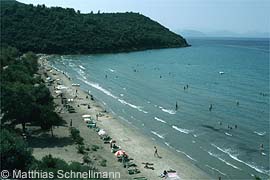
Fig. 9. Monk seal habitat in the Dilek Peninsula National Park, Turkey.
A similar situation exists in the ‘Mediterranean Seal Protection Zone’ on the Küdür Peninsula near Bodrum. Although a recent Ministry of Culture decree (establishing a Natural SIT area) provides strict protection against development, it cannot halt invasion of the area by water-bourne tourism. The relatively tranquil peninsula is surrounded by high-intensity ‘Tourism Investment Zones’ throughout the Bodrum Peninsula, thus casting some doubt on its viability to protect surviving monk seals (Kiraç & Veryeri 1996, Kiraç 1999, Kiraç & Polatkan 1999). Developers have already demonstrated their hostility towards setting aside the Küdür Peninsula for the monk seal, since large-scale development plans, including a marina, a yacht maintenance centre and a holiday village appear to have been scuttled as a result of the decision to establish the ‘seal protection zone’ (Kiraç 1999, Kiraç & Polatkan 1999).
Protected area status can also provide no guarantee of non-disturbance when there are no patrol boats to enforce regulations. Provisional results from the Foça SPA, for example, suggest that more seals used the protected area during the summer months of 1996 than in 1997 and 1998 – years coinciding with increased illegal activity due to a breakdown in guarding activities (Harun Güçlüsoy, pers. comm. 1998, Johnson 1998b,1998c). During this period (when the SPA’s sole patrol boat was sidelined due to mechanical problems and lack of funds), observers recorded tour boats passing only a few metres from critical monk seal breeding habitat at the Siren Rocks (Fig. 10). It is perhaps noteworthy that scientists cautioned almost a decade ago that disturbance to the seals in protected areas might actually increase without detailed management plans and long-term funding commitments (Texel 1990).
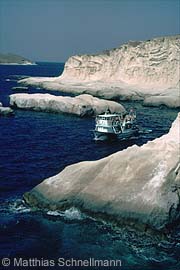
Fig. 10. In the Foça SPA, tour boats take advantage of the absence of effective guarding
by sailing only a few metres away from important monk seal caves.
In Greece’s flagship monk seal refuge, the National Marine Park of Alonissos and Northern Sporades (NMPANS), the need for regulations to secure the inviolability of the core zone was recognised by most of the negotiating parties involved in 1986, when summer disturbance of monk seals by marine tourism was recognised as a threat (Economou & Spiropoulou 1986). While human intrusion into the Park’s core zone, where breeding sites exist, is now strictly prohibited (Dendrinos 1994), the NMPANS is still awaiting – 7 years after its creation in May 1992 – the creation of an effective management authority (see New Law Benefits Protected Areas, Mediterranean News). Lack of a legally constituted management body was criticised by the leading NGO in the Sporades (MOm – the Hellenic Society for the Study & Protection of the Monk Seal) in 1995 as causing "considerable difficulties in the conservation of this area" (MOm 1996b). Although Park signs have recently been installed by the regional government (Nomarchia) in some areas of Alonissos, other previously announced initiatives have so far failed to materialise – such as a coherent plan to encourage ecotourism in the area, the production of information material designed specifically for tourists and the tourist industry, and similar measures to manage potential threats by tourism (Scoullos et al. 1994, Pakis Athanasiou, Yannis Vlaichos, pers. comm. 1999). More recently, a United Nations conference in December 1998 was told that "the park needed to be set up as a matter of urgency and tourism needed to be controlled" (UNEP/MAP 1998a).
At present, the NMPANS operates in a kind of legal twilight zone, with guarding being undertaken by a single NGO (MOm) rather than by government bodies. Due to funding constraints, only one patrol boat is available to the organisation, despite the necessity of guarding the Park’s 2200 square kilometres. During its unfamiliar role as regulations enforcer, the organisation found that illegal activities such as speargun fishing, scuba diving, and approach to prohibited areas were significantly reduced as a direct consequence of guarding activities (MOm 1996b). It also concluded that, compared to other threats, tourism must be considered particularly severe since it coincides with the monk seal breeding season. The intensity of the threat must also be taken into consideration. While MOm research has demonstrated that fisheries-related infringements are distributed at a low frequency over many months, tourism related incidents are concentrated only in the summer season, with a distinct peak in August (MOm 1996b).
While mass tourism can act as a barrier, blocking the establishment of reserves, or compromising the integrity of existing sanctuaries, it may also prevent monk seals from re-colonising areas from which the species has formerly been eradicated. This may be a particularly significant issue since a succession of conference recommendations have called for the protection of historical monk seal habitat to permit either natural recolonisation or translocation (UNEP/MAP 1987, Johnson & Lavigne 1998). In Israel, however, a coastal reserve established just south of the Lebanese border has been judged an unlikely site for recolonisation by Monachus, since the area is open to the public and caves are frequently visited by tourists (Ronald & Duguy 1984, Tamar Ron pers. comm. 1998). Similar constraints affect marine reserves of potential significance to the monk seal in Italy. While they exist on paper, inadequate management and guarding currently appear to make them uninviting areas for recolonisation by Mediterranean monk seals (Mo 1999).
Elsewhere, reintroduction (and also natural recolonisation) of the monk seal in the Canary Islands has effectively been shelved, partly because of tourism pressures on Isla del Lobos, a Natural Park. Despite controversy over its concept, methods and chosen reintroduction site, the project received substantial infusions of cash from the EU (Johnson & Lavigne 1998).
Balancing Tourism & Conservation Interests
Because of its shy and retiring nature, and its sensitivity to human disturbance, there is a long-held scientific consensus that monk seals and mass tourism cannot coexist in the same geographical location.
However, the design of protected areas cannot help but recognise that coastal communities have become increasingly dependent on tourism even in more remote areas. There is also general acceptance that marine protected areas cannot succeed unless local people participate in the conservation process.
On occasion – and with diminishing frequency over the years – scientists have raised the possibility of monk seals earning their survival by becoming a source of income for local communities. It was hoped, in particular, that coastal fishers might be tempted to relinquish their traditional hostility towards the seals by ferrying sightseers into protected areas, and even acting as park wardens (Ronald 1981, Harwood 1987a, Anselin & van der Elst 1987). In this respect, proposals for protected areas in both the Dodecanese and the Northern Sporades in the late 1970s advocated buffer zones where tourists might be encouraged to join seal-watching tours. In merging conservation and soft tourism interests, it was also hoped that sufficient revenue would be generated to compensate fishers for net damage, always regarded as an unsustainable financial burden (Ronald 1977). Despite its apparent advantages, it was also recognised that such non-consumptive use presented its own risks and would have to be strictly controlled (Council of Europe 1986a). In the case of the Northern Sporades, for example, where this type of scheme was discussed in the mid-1970s, seal-watching cruises were only recommended outside the August-October pupping season, effectively barring such activities during the short-lived tourist season (Schultze-Westrum 1976).
While no scientist can gauge the tolerance of the Mediterranean monk seal to disturbance, it has also been speculated that, if shielded from harassment, the species might conceivably regain the trusting nature for which it was so renowned in antiquity (Ronald & Duguy 1979, Johnson & Lavigne 1999).
Although this view may seem somewhat far-fetched, there is some circumstantial evidence to support it. The monk seal’s change in temperament appears to have been a relatively recent phenomenon, driven by human persecution, habitat deterioration and an inevitable reduction in gregarious behaviour (Johnson & Lavigne 1999). Juvenile monk seals, in particular, have been recorded showing little fear of humans, suggesting that such distrust may be a behaviour learnt from experience, rather than an inherited trait. Individual seals have been observed playing or swimming with divers (IUCN/UNEP 1988) and even venturing frequently into busy harbours (Ronald & Duguy 1979, Johnson 1988).
Regardless, it appears – as noted earlier – that the monk seal ‘temperament issue’ is inherently interrelated with the issue of habitat deterioration. Some scientists, for example, believe that some return to sandy beaches might be essential for the species to survive (Anderson 1979, Ronald & Duguy 1979, Johnson & Lavigne 1999). By the same token, it will require stringent protection on the part of humans and a certain element of regained trust on the part of monk seals, for that habitat change to take place. While it is theoretically possible that eco-tourists may one day watch Mediterranean monk seals dozing on beaches or playing with their pups along the shore, it remains open to question whether governments have the political will to institute the stringent conservation measures required. Without such precautions, reserves may only create the illusion of protecting the species, while doing little more than slowing a continuing decline (Texel 1990).
Some monk seal protection projects have attempted to integrate alternative development opportunities, such as ecotourism and organic farming, into conservation management plans. While such aims are broadly consistent with conservation priorities and compatible with local culture, they have met with little tangible success. For the most part, failure to institute such integrated conservation measures can be attributed to lack of investment, and to the fragmentary and haphazard approach so common to 20th century conservation (Johnson 1988, Johnson & Lavigne 1998). International organisations that have failed or reneged on commitments to pursue such holistic approaches – either due to financial constraints, bureaucratic malaise or short-sightedness – have bourne the brunt of some criticism over the years (Johnson 1988, Jacobs & Panou 1996, WWF Mediterranean Programme 1994). In some cases, failure to implement promised measures of this type have caused a local backlash against the core objectives of monk seal conservation projects (Jacobs & Panou 1996).
An Assessment of Conservation Actions
Available evidence suggests that there has been little tangible progress in eliciting the financial and political support of the international tourism industry for monk seal conservation efforts. The monk seal conservation community – most notably as a consequence of inadequate coordination and bureaucratic malaise in implementing internationally agreed measures – must shoulder some of the responsibility for this failing (Johnson & Lavigne 1998, Reijnders 1998).
In terms of fulfilling the specific recommendations of conferences and action plans, for example, there has been little effort expended in preparing, translating and disseminating multimedia public awareness packages aimed at the tourism industry, as called for in the UNEP Action Plan (UNEP/MAP 1987).
By the same token, the tourism industry continues to demonstrate indifference – and even hostility – towards the plight of the species. Even where tourism interests have been invited to join the conservation process, it appears that participation has been geared more towards hindering the conservation agenda and staking territory than in acknowledging the industry’s role in driving the species into oblivion (Kiraç 1999, Kiraç & Polatkan 1999).
In such cases, it may be realistic to assume that governments – at least implicitly – regard monk seal conservation as a potential threat to the tourism industry, a major source of revenue for most Mediterranean nations. Tourism has undoubtedly pumped billions of dollars into the region, while also fattening the corporate accounts of airlines, multinational package tour operators, charter and hotel chains. In contrast, frontline monk seal conservation projects generally suffer from severe funding constraints (both in amount available and in continuity) compromising long-term planning and execution of conservation programmes (Johnson & Lavigne 1998, Johnson 1998b, 1998c, 1999). This is in spite of the fact that in many areas of endeavour, such projects are directly addressing the conservation problems engendered by the tourism industry.
Indeed, instances of the industry funding or otherwise supporting monk seal conservation efforts are few and far between according to reports from Greece and Turkey (Harun Güçlüsoy, Gerald Hau, Cem Kiraç, Aliki Panou, Vrassidas Zavras, pers. comm. 1999).
While the formation of HELMEPA (the Hellenic Marine Environment Protection Association) in 1982 by the Greek shipping industry was greeted with some optimism by Ronald & Yeroulanos (1984), the group appears to have achieved little tangible for the monk seal, despite the great affluence of its members.
The Greek-owned shipping company, Minoan Lines, installed MOm collection boxes on its Italy–Greece car ferries, and also continues to promote and sell its own monk seal merchandise in its on-board shops (Fig 11). To an industry that calculates annual profits in the billions, however, it must be said that this contribution, however welcome, amounts to little more than small change.
The situation appears to be little different in Turkey, with researchers indicating that they have no recollection of the tourism industry ever having provided funds or other support to monk seal conservation efforts (Harun Güçlüsoy, Cem Kiraç, pers. comm. 1999).

Fig 11. A Minoan Lines monk seal tablemat.
Copyright © 1999 William M. Johnson & David M. Lavigne, The Monachus Guardian. All Rights Reserved